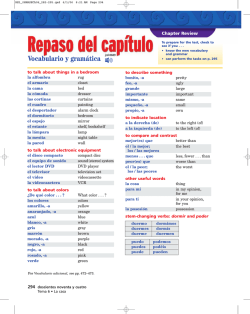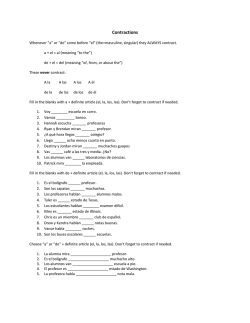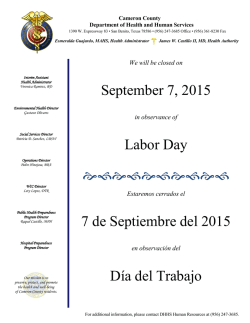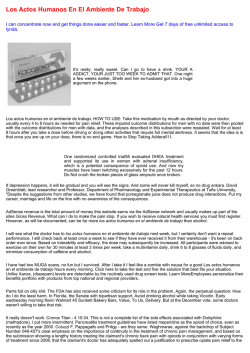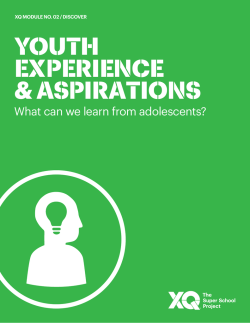
Leer más - Ifejant
JOINT LETTER TO THE CHILDREN’S RIGHTS COMMITTEE The Training Institute for the Working Children and Adolescents “Nagayama Norio” – INFANT (1998) and the Training Institute for Youth, Adolescents and Children’s Educators in Latin America and the Caribbean “Mons. German Schmitz” – IFEJANT (1989) have been educating for the defense, promotion and fulfillment of children and adolescents’ rights in Peru, specifically of those who work (working children and adolescents – NATs). It is of our knowledge that the Committee is preparing a General Report on children and adolescents’ rights regarding particularly Adolescent’s Rights including for us Article 32 of the Convention on the Rights of the Child (CRC), which motivates our letter and allows us to openly share what our institutional experience in Peru and Latin America, where we operate, has been showing us throughout the years. In that sense, we believe that international rights treaties such as ILO’s C.138° and 182°, which refer to the minimum work age and children’s protection from any form of child labor respectively, deserve our clear reservation and we ask its necessary substitution by the following: That, considering their autonomy and full empowerment of their rights, specifically expressed on Art. 32° of the CRC on children’s protection from any form of economic exploitation, under no circumstance there is work prohibition, thus any agreement, international treaty or program 1 that expresses an opposite argument against this right, which is recognized by almost all countries who ratified the CRC, attacks its integrity. That throughout our experience facilitating spaces for the training of working children and adolescents, as well as for educators, we have indentified the familiar link that develops and strengthens from their participation in the family economy thus facing poverty in a collective manner. The Critical Appraisal of Work, which inspires the children and adolescent’s organizations in Peru, demands an appreciation of every child worker. To value, does not mean to ignore the real conditions in which they have to survive, through, not only sacrifices, but also their unfulfilled rights. However, there is no an emancipating pedagogy without significant appreciation of the human condition, dignity, negated to every child worker. On the other hand, the message sent by the C.138° and 182° is, in practice, punitive and penalizing, that means anti-educative because it pretends to be universal and homogenizing of a phenomenon that is much more complex, multicausal and diverse 2. That, considering the approval of the Convention on the Rights of the Child (CRC), they are recognized as social bearers with rights and under this parameter, any form of economical participation from any form of work – always under dignifying conditions – reaffirms their political recognition. That is the reason why any time that the efforts are oriented to promote children’s faculties must look for ensuring the empowerment of their role within social policies and the 1 2 See OIT y su Guía para Parlamentarios para la aplicación del C.182, del 2002. See de nuestro colaborador e investigador Giangi Schibotto, “Sobre las estadísticas de infancia y trabajo en Colombia”, 2014, Cuadernos del CIDIS, U.Externado de Colombia: “…hace algunos años un conocido investigador y asesor de organismos internacionales , el peruano W.Alarcón G, de larga y honesta trayectoria en el tema del trabajo infantil, en estudio sobre los NNATs en las comunidades campesinas de los Andes de Huancavelica encuentra que la actividad de la infancia es compleja y matizada, y que un enfrentamiento rígido y sin distinciones no sería justificado, p.71. El diálogo intercultural implica respeto y tolerancia. Entender que el conocimiento es una puerta siempre abierta y es un proceso colectivo. Nadie tiene el monopolio de la verdad”. Además, M.Liebel, I.Saadi, “Las estadísticas engañan…”, 2014, Rev.I.NATs, n.23-24; Jorge Domic, “La concepción andina de la infancia y el trabajo”, 2004, Rev.I.NATs, n.11-12, p.31-37; Grimaldo Rengifo, “Conocimiento previo y conocimiento otro”, 2014, Pratec. change of the social norm together with the familiar and adult world. It is in that sense that participation in based on a concept of individual and social responsibility supported by the CRC spirit. That under no premise or preamble, flagrant crimes can be recognized as forms of child work as argued by the C.182 – ILO: It is unacceptable that prostitution, human trafficking and child-soldiers can be classified as work as if work refers only to a matter of acquiring economical resources. That, in accordance with public policies, and local and international efforts to achieve that all people fully “enjoy” their rights, freedom to choose and make decisions; we must insist this becomes more than a premise or a utopia, often obstructed by homogenous practices in diverse realities. Today, the C.138° and 182° cannot hide their objective neo-colonizing tendency, functional to a homogenous civilizing model. We are a millenary multiethnic country, multicultural and multilingual. In our Indigenous Peoples, participating from early childhood – considering development and growth – in daily productive activities – which in other context are termed work – in the way to be part of and enhance identity with the community. Thus, we consider unacceptable campaigns launched by the ILO, since the Cartagena Conference in 2010, against the work of indigenous children and the work of children in rural areas as such. Thus, we encourage the UN- Children Rights Committee’s members to reaffirm the CRC Article 32°, the right to protect from economic exploitation all children and adolescents who work to ensure respect to their dignity. We hope that the General Report that is being prepared, does not allows the life of millions of children and adolescents, expelled out of the civilizing model to human insignificance, to become more rigid and out of reality. We are fully aware that no culture is perfect. All are perfectible. Thus, the culture that underlies C.138° and 182°, cannot raise untouched. It requires the inclusion of other perspectives upon a reality that is historically diverse 3. We rely on the Committee not to succumb when faced with pressure based on moralist statements, utopian arguments such as those which since 25 years ILO and IPEC have preaching 4, or when faced with statistics that often pretend to show achievements unfortunately denied by reality 5. In order to keep building a fair and dignifying society for all, and especially for children and adolescents, we hope to keep having your support, without forgetting asking: “And do you really want us to still believe those stories about eliminating, in a short period of time, those worse forms of child labor”? We believe that it is more serious and honest to 3 Stella Calero, “Análisis crítico del discurso aplicado a las campañas en contra del trabajo infantil promovidas por OIT en el período 2007-2009”, 2012, en Rev.I.NATs, n.21-22, p.104-121; A.Cussianovich, “Una mirada otra sobre trabajo infantil: Imperativo ético y exigencia política”, 2010, Rev.I.NATs, n.19, p.13-20; Matías Cordero A, “Hacia un discurso emancipador de los Derechos de las Niñas y Niños” ,2015, Ifejant, p.307 ss. 4 Informes globales de la OIT: “Un futuro sin Trabajo Infantil.”, 2002; La eliminación del Trabajo Infantil.: un objetivo a nuestro alcance”, 2006; “Intensificar la lucha contra el Trabajo Infantil.”, 2010. Ver G. Schibotto, “El último informe global de la OIT: los vacíos, las incongruencias, entredichos y confusiones”,2014, Rev.I.NATs, p.26-35. 5 G. Schibotto, op.cit:¿“…se trata de un intento de convalidar por vía ‘matemática’, es decir, convencionalmente incuestionable, los supuestos ideológicos y los modelos de intervención hegemónicos de corte abolicionista, hoy en día debatidos por otras discursividades alternativas y críticas?”, p.20; “muchas veces las estimaciones se presentan con un sello de objetividad y de incuestionabilidad”, ib. recognize that on these 20 years of imposition of abolitionist paradigms nothing has been achieved, nothing more than hiding, stigmatizing and even criminalizing millions of children and adolescents who have been left unprotected in their most elemental rights or transformed on pious human stories useful for moving from a perspective of civil rights to compensating charity, under the so called “conditioned monetary transferences” 6. 6 Elvira Figueroa S Esther Díaz G IFEJANT-Director INFANT-Director Ibidem, p.164—165, ver Héctor Béjar “Te doy plata si…Las Transferencias monetarias condicionadas”, 2009, Boletín de la Asociación de Egresados y Graduados, PUCP, Lima; A. Cussianovich, “El ocultamiento de los derechos específicos de las NN en las nuevas salvaguardas del Banco Mundial”, 2015, Rev.I.NATs, n.25, p.85-102.
© Copyright 2025
